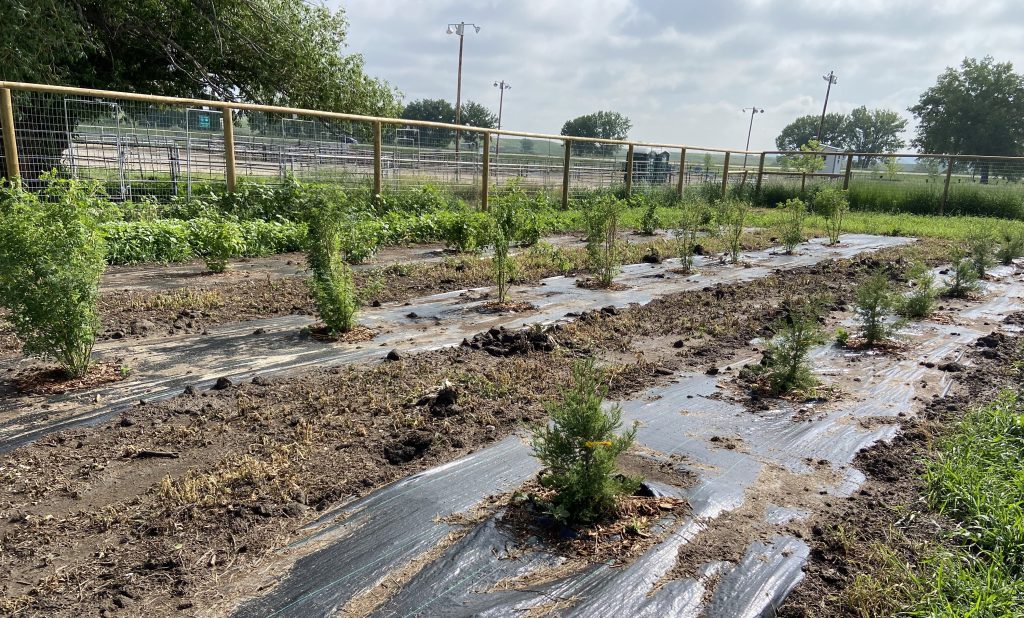Take advantage of summer months to prep for next winter’s weather
After the record-breaking cold and snow of the last six months, the last thing many ranchers want to think about is winter weather. However, summer is the time of year to take steps that will make next winter more tolerable.

Windbreaks are critical pieces of infrastructure that can reduce wind chill and its negative consequences. Not much can be done to stop the notorious Wyoming wind from blowing outright, but it can be manipulated and directed to provide relief and shelter for livestock.
The purpose of a well-designed windbreak for livestock is to provide shelter by cutting down the velocity of air movement and, in the case of blizzard conditions, to direct blowing snow away from a protected space. In harsh blizzard conditions, having access to space out of the wind can mean the difference between life and death for animals in a herd or flock.
Structure and design
The effective area of the windbreak is directly determined by its height, length, and density (relative amount of open space or gaps). A taller structure creates a relatively larger downwind protected space. Proper length is required to maximize the sheltered space.
The density of a structure influences the movement of air over or through it and the resulting pattern of snow drifting. Solid structures cause increased wind velocities over and around them, which results in a slight vacuum in the downwind side. Snow will accumulate first on the upwind side and then in the immediate downwind space as the slight negative pressure allows it to fall out of the air.
Porous structures allow some air to pass through, which reduces the vacuum effect and disperses blowing snow over a larger area. Windbreaks lose much of their wind-slowing effects at less than 50 percent solid density.
One of the most effective windbreak designs for livestock features two solid arms set at a 90-degree angle “V” with the point oriented directly into the prevailing wind. A map displaying the direction of local prevailing winds across Wyoming can be accessed at https://bit.ly/WYwind. Research shows the length between the ends of the two arms should be at least 10 times the height of the structure and no more than 15 times the height of the structure to maximize the shelter space.
For example, if you’re planning a 10-foot-tall windbreak, the minimum width between ends is 100 feet and the maximum is 150 feet. Using the Pythagorean theorem and a little high school algebra, the structure should have sides at least 70 feet long and no more than 106 feet long to fall within the targeted range. In this way, structures can be customized to any desired height or length.
The V-type solid windbreak directs snow to drift at the ends of the walls and creates a space of reduced air velocity in the downwind area 10 to 12 times the height of the windbreaks. Temporary versions can be built using round hay bales stacked two high, with the bottom bale placed on its end and the top bale placed on its side. Follow the dimension limits described above.
Shelterbelts
Shelterbelts, which consist of rows of trees and shrubs, make excellent porous windbreaks. Many factors contribute to the efficacy of shelterbelts as windbreaks, including plant spacing, species composition, and number of rows. Shelterbelts typically have at least one row of evergreen trees, but they can feature any combination of evergreen, deciduous, and shrub species in one or more parallel rows. This type of planting is sometimes referred to as a living snow fence.
Wyoming’s dry climate and cold winters can make it difficult to keep trees alive long enough for them to establish. Sites without access to supplemental water should prioritize manufactured windbreaks over shelterbelts.
In places where access to water is not limiting, selection of appropriate tree and shrub species is a critical factor in the successful establishment of a shelterbelt. Plants native to Wyoming are well-adapted to the soil and climate, but good non-native options are also available. Contact your local UW Extension office for recommendations for plant species appropriate to a specific location. Visit the “trees and shrubs” page of UW’s Barnyards & Backyards website, located at https://bit.ly/BnBtree, for additional resources on living snow fences and windbreaks.
Spacing will vary according to the tree and shrub species selected for a shelterbelt, but research recommends allowing 3 to 4 feet between shrubs, 6 to 15 feet for deciduous trees, and 6 to 20 feet for conifers to maximize wind shelter effect without overcrowding the plants.
In addition to wind reduction, shelterbelts provide wildlife habitat, homeowner privacy, aesthetic value, and other benefits.
Think before doing
A common issue with windbreaks and shelterbelts is spacing them too close to the areas targeted for protection, which causes snow to drift around feed bunks, sheds, barns, houses, and roads. The general recommendation is to place the windbreak at least 150 feet away from the area to be protected. The exact distance can be calculated according to the specific height and density of a windbreak structure on a case-by-case basis. Remember, constructed windbreaks can be moved, while planted shelterbelts cannot—due diligence in the planning phase will save time, money, and headaches.
With winter in the rearview, it’s tempting to focus on the sunny days ahead. However, installing windbreaks this summer and taking the time to do it right the first time will pay off when the snow is blowing and the winter wind is howling once again.
Micah Most is the agriculture and natural resources educator with University of Wyoming Extension serving Johnson County. He can be reached at mmost@uwyo.edu or (307) 684-7522.




